When the House of Representatives passed a largely-symbolic package of gun-control measures what was most interesting is the policy they didn’t include: an “assault weapons” ban.
Polling gives some insight into that intentional oversight. While support for every other gun-control proposal increased in the wake of the Uvalde and Buffalo shootings, support for an assault weapons ban fell to its lowest level ever. Combine that with the fact no new assault weapons ban has passed in 25 years and you start to see why I’m willing to say the era of the ban is over.
Konstadinos Moros takes a look at data that shows another important point: people with concealed carry licenses almost never commit crimes. Reports from Texas, Florida, and Minnesota provide detailed information on just how rare those crimes are.
Contributing Writer Jake Fogleman takes a closer look at that House-passed gun package. He explains what it does and how the vote for each measure shook out.
Plus, Punchbowl’s John Bresnahan explains what’s really happening with bipartisan gun policy talks in the Senate.
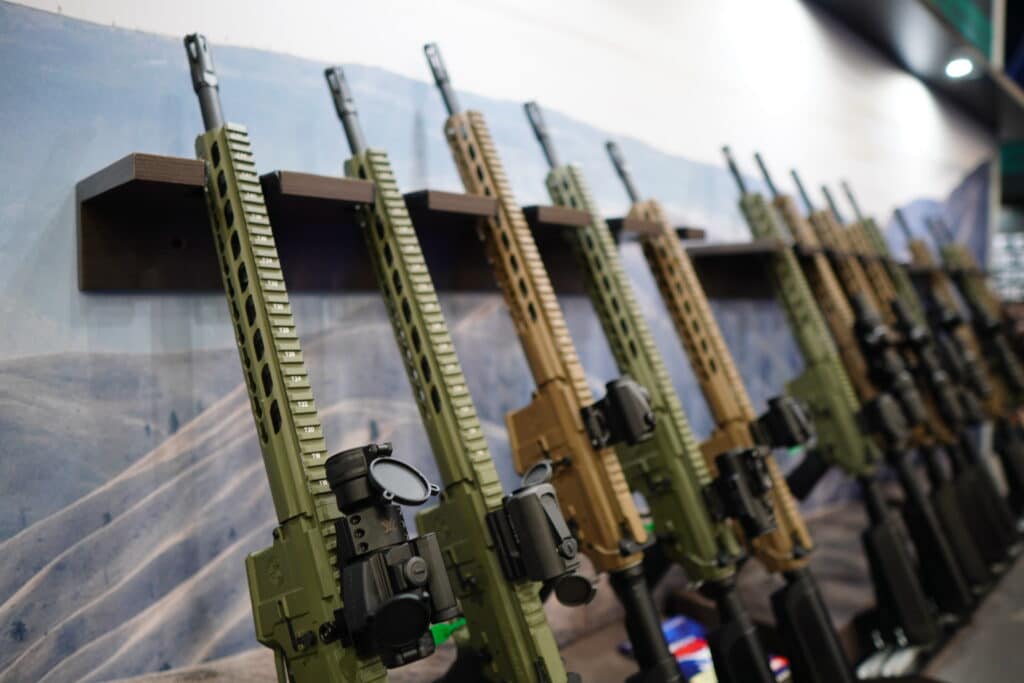
Analysis: The Era of ‘Assault Weapons’ Bans is Over
By Stephen Gutowski
There will not be a new federal “assault weapons” ban this year. Or any year in the near future.
It’s not simply because of Senate Republican opposition either. The Democrat-controlled House of Representatives won’t pass one. It hasn’t even tried to since the party took control in 2018.
In fact, there hasn’t been a new assault weapons ban in 25 years. Only seven states and the District of Columbia have a ban in place at all. Some of those states, including New York and California, have tightened their prohibitions in recent years. But no state has passed a new ban in recent history.
Gun-control advocates haven’t given up on pushing the policy, though. And some top Democrats, including Texas gubernatorial candidate Beto O’Rourke and Vice President Kamala Harris, have even advocated coupling a sales ban with a mandatory buyback.
But the hill to climb for successfully passing a new ban has just gotten steeper.
In the first major poll since the shootings in Uvalde and Buffalo, Quinnipiac University found support for an assault weapons ban actually dropped. It’s now at just 50 percent, which is the lowest level it has ever been since Quinnipiac started asking about a ban in 2013.
The newest finding puts support for banning assault weapons 17 points lower than its peak just a few years ago. It’s just one poll, of course, but others show a substantial drop in support since the national ban passed back in 1994. One of the oldest polls on a ban found support was up at 80 percent.
The Quinnipiac poll is telling beyond just the raw numbers too. In the wake of horrific shootings, such as the recent attacks in Buffalo and Uvalde, support for gun-control measures tends to increase significantly. For nearly every other policy Quinnipiac polled, that was the case. But not for an assault weapons ban.
And, again, it wasn’t just Republicans driving opposition to a ban. Independents also opposed the ban by a three-point margin.
It’s too early to say for sure this trend will continue. More polling will be needed to have confidence that’s the case. However, America has experienced a similar policy transformation in recent history.
Handguns were once the main focus of gun-control efforts. Brady United Against Gun Violence was initially called Handgun Control Inc. and once partnered with the Coalition to Stop Gun Violence which was initially called the National Coalition to Ban Handguns.
In 1959, Gallup found 60 percent of Americans favored a total ban on handguns. But, as time went by, that number began to fall. By 2021, the same poll found just 19 percent support. That’s even though handguns are by far the most common weapon used in homicides and other serious crimes.
That attitude shift likely had a lot to do with the increasing popularity of handguns among the general public. Multiple polls over the past decade or more indicate people buy guns primarily for self-defense. At the same time, handguns have surpassed rifles and shotguns as the best-selling category of firearms in the United States.
Assault weapons may be enjoying a similar effect. While “assault weapon” is a fairly nebulous term with a definition that varies from state to state, it’s usually crafted in a way to target guns like the AR-15 and Ak-47. The National Shooting Sports Foundation calls these guns “modern sporting rifles.”
In 2020, they estimated there were nearly 20 million AR-15s and similar firearms. They are the most popular rifles in the country, and the NRA has even dubbed the AR “America’s rifle.” More Americans own ARs than ever before and likely associate them more with home defense, hunting, and sport shooting than with crime, despite their presence in some of the highest-profile mass shootings.
That doesn’t mean further regulation of assault weapons is impossible. After all, handguns are more highly regulated than rifles or shotguns despite the minuscule support for a total ban on their sales. Similarly, support for age restrictions on purchasing assault weapons has polled very well in the wake of the recent shootings, and New York just implemented that change.
Perhaps that’s where the debate over AR-15s and other “assault weapons” will now focus. Because a total ban on sales is not in the cards anytime soon.
Podcast: Punchbowl’s John Bresnahan on Senate Gun Talks [Member Early Access]
By Stephen Gutowski
This week we have one of the top Capitol Hill reporters on the podcast.
The House passed a package of gun-control bills and bipartisan discussions in the Senate have been making progress towards a deal. So, I wanted to bring on Punchbowl Co-Founder John Bresnahan to give us a breakdown of where this is all really headed. Bresnahan has been reporting on the Hill for as long as anybody, and nobody else has a better view of what’s going on.
He said Senators John Cornyn (R., Texas) and Chris Murphy (D., Conn.) are the key players. He said the two are genuinely trying to come to a deal, and the odds of a gun bill package passing the Senate are higher than they’ve been in years.
Bresnahan said the policies that have passed the House are non-starters in the Senate. Instead, Senators are looking at other solutions. The top ideas so far are including some juvenile criminal records in the FBI background check system, “red flag” model legislation coupled with a state grant program, and expanding a mental health funding program to all states.
However, Bresnahan cautioned that the real threshold for a successful bill is whether it can attract not just 60 votes but also a majority of Republican support. He said he remains skeptical something can actually get across the finish line. He’s still watching to see if and when an actual written bill comes together.
Plus, Contributing Writer Jake Fogleman and I discuss New York’s new gun laws and the foiled plot by a gun-control advocate to kill Justice Brett Kavanaugh.
You can listen to the show on your favorite podcasting app or by clicking here.
Video of the full episode is also available on our YouTube channel.
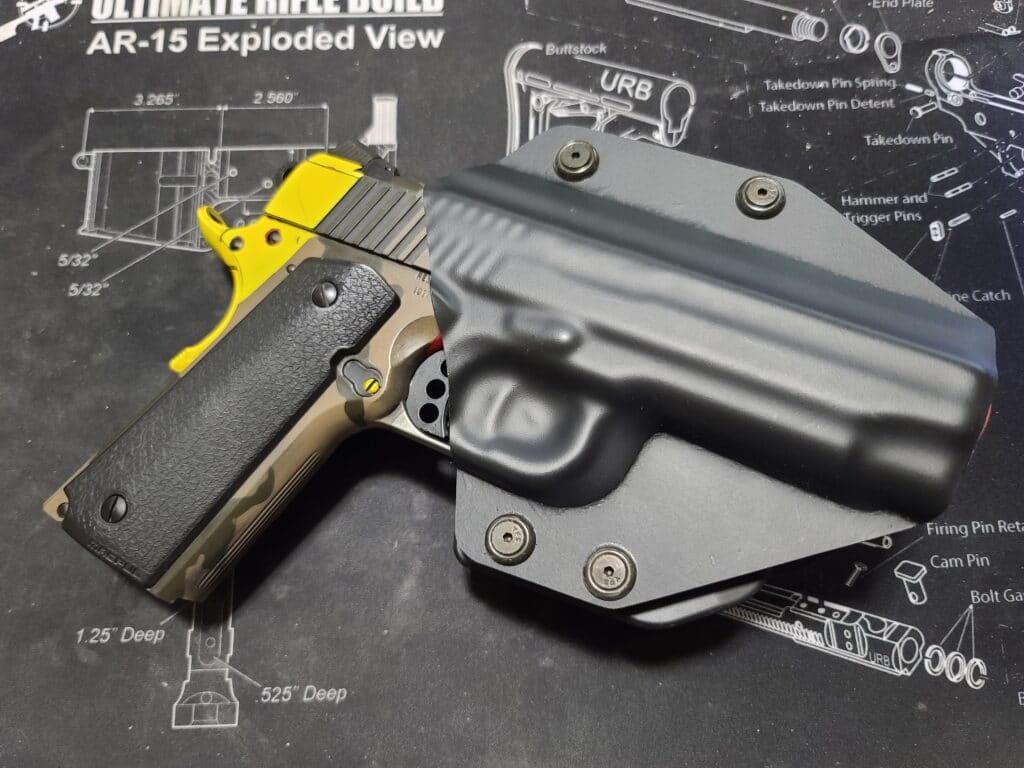
Analysis: Data Shows People People With Carry Permits Almost Never Commit Crimes [Member Exclusive]
By Konstadinos Moros
Since the 1980s, the right of law-abiding citizens to carry has expanded tremendously. Before then, only a handful of states permitted carrying firearms by regular citizens. But with Florida becoming by far the largest state expanding the right to carry in 1987, a media firestorm ensued. Gun-control activists insisted that the state would devolve into a sort of “wild west.”
So, did Florida come apart at the seams with every disagreement turning into the O.K. Corral? Not at all, according to the data. Florida’s homicide rate actually fell following the passage of its “shall-issue” gun-carry law. In 1987, it had 11.4 murders per 100,000 people. But, by the start of the new century, the rate had been cut to 5.6 per 100,000.
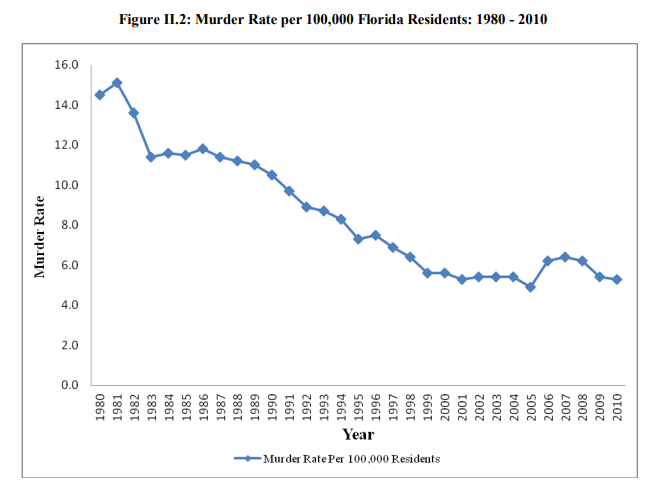
While we cannot conclude the carry law caused murder in Florida to drop, it is safe to say that the decline refuted opponents’ predictions of dire consequences.
“There are lots of people, including myself, who thought things would be a lot worse as far as that particular situation [carry reform] is concerned,” Florida Representative Ronald A. Silver (D.), who opposed the law, said in 1990. “I’m happy to say they’re not.”
John Fuller, general counsel for the Florida Sheriffs Associated, added: “I haven’t seen where we have had any instance of persons with permits causing violent crimes, and I’m constantly on the lookout.”
Yet opponents have never given up the talking point that expanding carry rights makes crime rise. Indeed, that is the basis of their current fears over the Supreme Court’s upcoming decision in New York State Rifle & Pistol Association Inc. v. Bruen. In that case, the Court is deciding whether New York’s “may-issue” permitting system, which allows government officials to subjectively deny concealed carry applicants who complete safety training and pass a background check, violates the Second Amendment.
We won’t know for sure what the Court’s ruling will be until it is published. But most scholars expect SCOTUS will make “shall-issue” permitting, where government officials have to issue permits to those who complete training and pass a background check, the law of the land.
While some studies have claimed that “shall-issue” permitting systems cause crime to rise, the RAND corporation’s review of those studies decided that they were mostly inconclusive. Rand found some studies show increased crime, and others showed decreased crime. Even among the studies that claimed increased crime, however, none had evidence that the people with carry permits caused the increased crime. And that’s for a very good reason: reliable and comprehensive state-level data on that topic shows that people with carry permits are overwhelmingly law-abiding.
Take Texas, for example. 2020 was the last complete year where permits were issued before Texas passed permitless, or “Constitutional,” carry. That year, Texas had 1,626,242 active concealed handgun license holders. That same year, 573 people with those licenses did something that caused the state to revoke their licenses. That’s just 0.03% of the total amount of people with licenses.
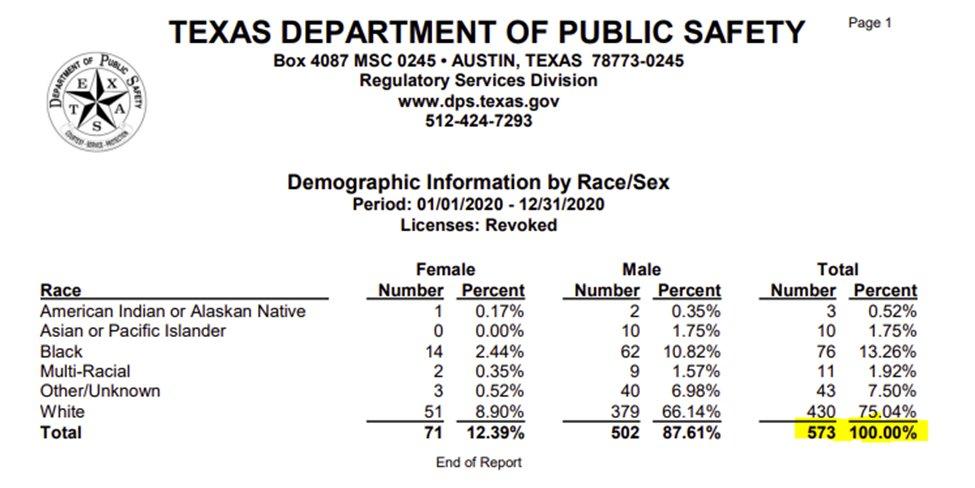
Overall in 2020, Texas license holders were 5.7% of the state’s population, yet they were convicted of just 0.43% of the state’s serious crimes. There were 114 convictions for license holders out of 26,304 convictions for the state as a whole. And many of the offenses listed in the five-page PDF do not involve a firearm at all.
Florida has 2,323,336 residents with active Concealed Weapon Licenses as of May 31, 2022. (After the 200,000 or so out-of-state licenses are excluded from the total.) From July 1, 2020 to June 30, 2021, the state revoked just 1,050 licenses. Another 5,684 were suspended, though it does not appear all suspensions end up being permanent revocations. That equates to a revocation rate of just 0.04% per year. In fact, since “shall-issue” began in the 1980s, the state has revoked just 18,267 licenses out of a total of 5,351,852 issued. And 1,463 of those were later reinstated. That means only about 0.3% of Floridians who get a carry permit ever have it permanently revoked. Unfortunately, unlike in Texas, the reasons for revocation are not broken down in the available data.
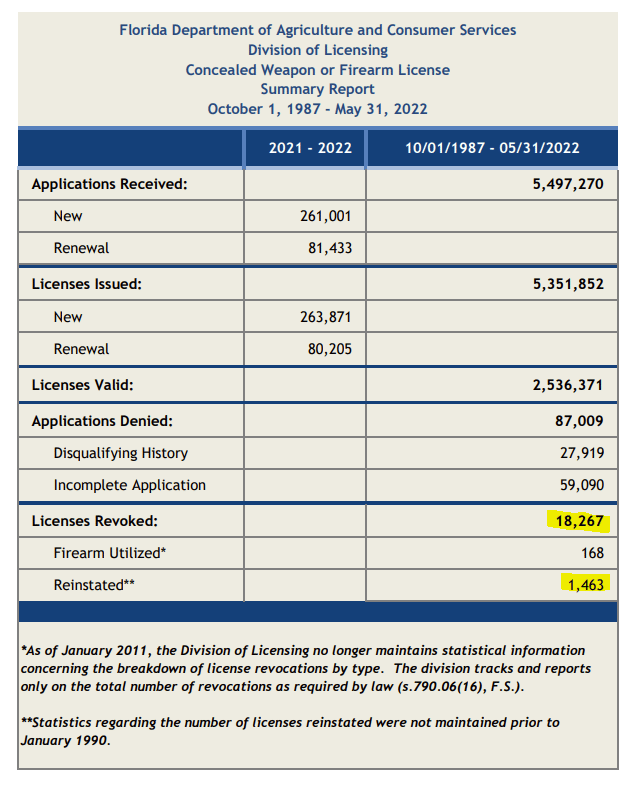
As a final example, let’s look at Minnesota. Based on the Minnesota Department of Public Safety, the state had 387,013 valid carry permits in 2021. The state only revoked 40 of those that year. While the state reports that people with carry permits committed 3,863 “crimes,” a much higher rate than what we saw in the Texas data, the discrepancy seems to be because Minnesota is more inclusive of what it considers a crime (61% were DWIs or other traffic offenses). Only 2% of the 3,863 crimes involved a firearm. So, even when people with a carry permit do commit crimes, their permits are rarely relevant to those crimes.
Doing the math in Minnesota’s case, just 0.02% of permit holders used a firearm in furtherance of a crime.
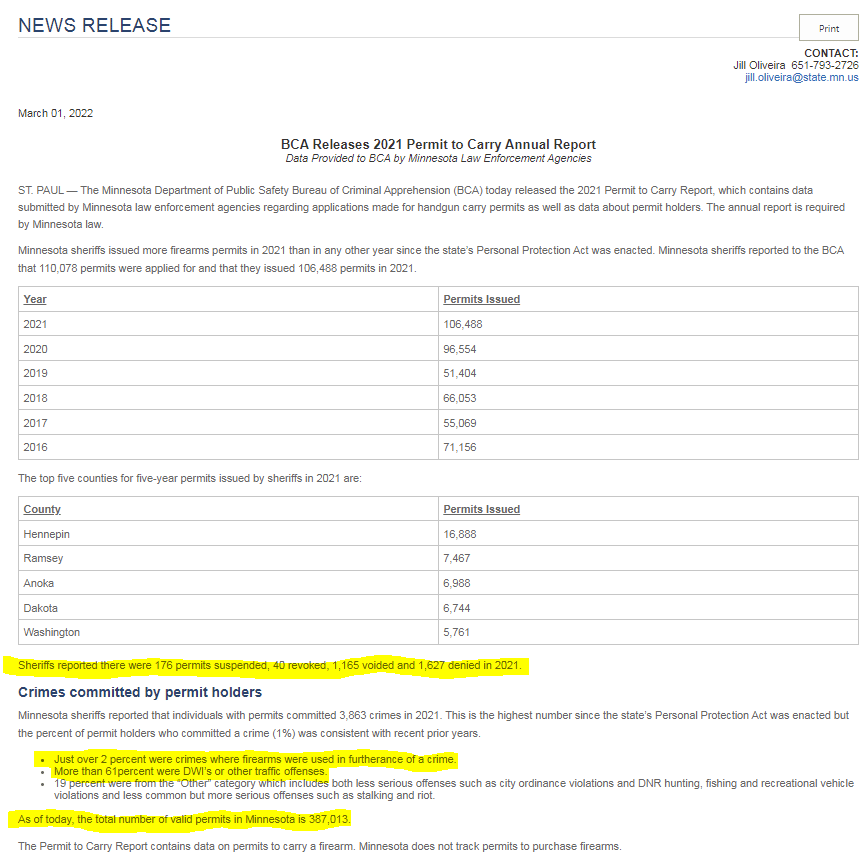
The evidence shows people with carry permits are overwhelmingly law-abiding. And common sense can likely explain why. If an individual gets a carry permit before carrying a gun, they are demonstrating a predisposition to follow the law.
Similarly, someone more prone to criminal actions is unlikely to bother with or care about a permit requirement.

Analysis: A Look at the House Gun-Control Package That Just Passed [Member Exclusive]
By Jake Fogleman
The House passed a broad gun-control package on Wednesday, but what exactly does it do?
The full bill contains seven separate gun-control measures ranging from new age restrictions for firearm purchases to bans on certain ammunition magazines. The overall bill passed 223-204, though each measure received a vote of its own. Five Republicans joined the Democratic majority in supporting the complete package, while two Democrats broke with their party and voted against the bill.
Here’s a look at what passed, how the votes played out between the parties, and what Democrats left off the table in the largest federal gun control package advanced in years.
New Age Restrictions
Title one of the legislation includes a new prohibition on certain rifle and shotgun sales, including the popular AR-15, to individuals under the age of 21. The measure prohibits federal firearms licensees from selling “any semiautomatic centerfire rifle or semiautomatic centerfire shotgun that has, or has the capacity to accept, an ammunition feeding device with a capacity exceeding 5 rounds” to anyone under 21 who isn’t a “qualified individual.”
A “qualified individual” would be a member of the Armed Forces while on duty or any other government employee authorized to carry a firearm as part of their official duty.
This measure passed 228-199, with 10 Republicans voting yes and two Democrats voting no.
Gun Trafficking and Straw Purchases
Title two of the bill added rewrites current prohibitions against illicit gun trafficking and purchasing a firearm for third parties.
The bill specifies it shall be illegal for a person to acquire a firearm for a third party or to solicit another person to acquire a firearm on behalf of a third party, acts already illegal under federal law. It includes an exception for people buying guns for family members if they are a “bonafide gift” so long as the family member is not prohibited from owning guns or intending to use them in a crime. That’s something else already allowed under current federal law.
Violations of the law would be subject to a fine and/or up to 10 years in prison.
This measure passed 226-197, with seven Republicans voting yes. Jared Golden of Maine was the only Democrat to vote no.
“Ghost Guns”
Title three of the bill added a definition of ghost guns to federal firearms law, banned their possession and future sale, and clarified new methods of “manufacturing firearms” to encompass modern techniques such as 3D printing. The measure defines a ghost gun as “a firearm, including a frame or receiver, that lacks a unique serial number engraved or cast on the frame or receiver by a licensed manufacturer or importer.” It effectively outlaws the homebuilding of firearms.
Exceptions for sales and transfers of “ghost guns” would apply only to licensed manufacturers. Violations would carry a penalty of up to one year in jail, with subsequent violations carrying a sentence of up to five years.
This measure passed 226-194, with eight Republicans voting yes. Jared Golden of Maine was again the only Democrat to vote no.
Safe Storage Requirements
Title four of the bill will create a federal offense if a person keeps a firearm without a “using a secure gun storage or safety device” if they live with a person prohibited from owning firearms or with a minor. Violations of the act would carry a $500 fine and government confiscation of the improperly stored gun.
If a prohibited person or minor can access an improperly stored firearm and proceed to kill or injure someone, the penalty increases to up to five years in prison.
The bill also contains multiple grant programs from the federal government to incentivize states and Indian tribes to promote safe storage practices.
This measure passed 220-205, with three Republicans voting yes and two Democrats voting no.
Bump Stock Ban
Title five of the bill adds a federal prohibition on manufacturing, selling, or possessing bump stocks even though the Department of Justice banned the devices through rulemaking under the Trump Administration.
The bill’s language defines bump stocks as any manual, power-driven, or electronic device, or any part or combination of parts, that “eliminates the need for the operator of a semiautomatic weapon to make a separate movement for each individual function of the trigger and materially increases the rate of fire of the semiautomatic weapon, or approximates the action or rate of fire of a machinegun.” That’s a definition that likely extends the ban well beyond just bumpstocks.
This provision passed 233-194 with unanimous Democratic support and 13 Republicans.
Ammunition Magazine Ban
Title Six of the bill would ban the sale of ammunition magazines capable of holding more than 15 rounds, with limited exceptions for law enforcement and certain security personnel. The bill would mandate all future magazines manufactured that are capable of holding more than 15 rounds be serialized and include the date of manufacture.
Magazines already owned by Americans would be grandfathered in by the bill. However, the bill also establishes a grant program to help states “buy back” those magazines.
This provision passed 220-207, with four Republicans joining Democrats to support the measure. Four Democrats voted against it.
Background Check Report
Title Seven of the bill would require annual reports from the United States Attorney General to both chambers of Congress containing detailed demographic data on individuals who attempted to purchase a firearm but failed a background check for a given year.
This bill saw the most unanimity in support between the two parties. It passed 380-47, with 160 Republicans joining every Democrat in voting for its passage.
What It Means For Gun Policy
While the bill is remarkable for the scope of different gun policies it attempts to tackle at once, Democrats notably omitted one major policy. Despite hints from Democratic House leadership, the package didn’t include an assault weapons ban. It hasn’t been scheduled for a vote either.
That omission coincides with new polling suggesting public support for the policy is at its lowest level in a decade.
But even without a federal “assault weapons” ban, the bill represents the most substantive action taken on federal gun policy by either chamber of Congress in many years. But its fate is likely already sealed. With the Senate as closely divided as it is, there’s just no realistic shot of the gun-control package advancing any further.
That’s it for now.
I’ll talk to you all again soon.
Thanks,
Stephen Gutowski
Founder
The Reload



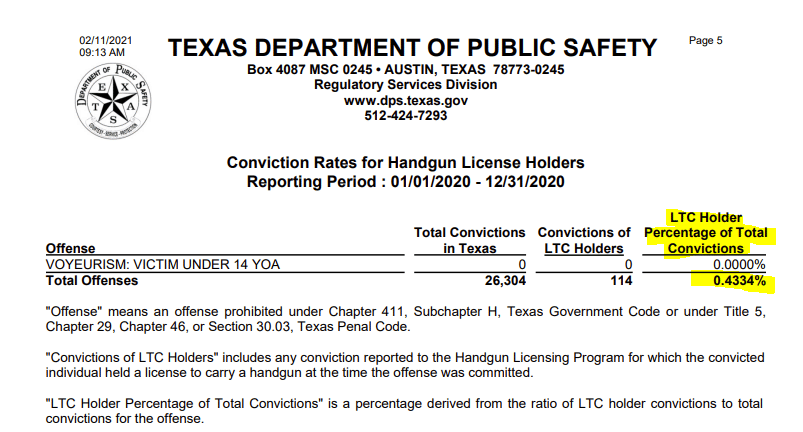





Only Members can view comments. Become a member today to join the conversation.